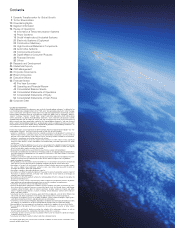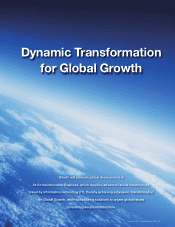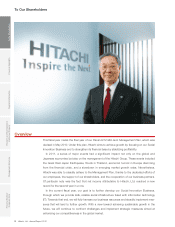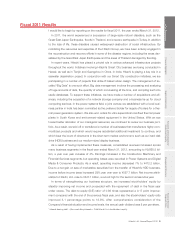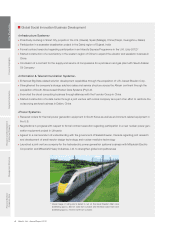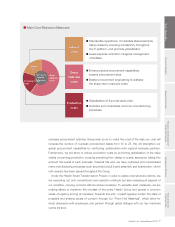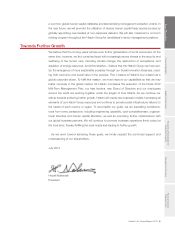Hitachi 2012 Annual Report Download - page 8
Download and view the complete annual report
Please find page 8 of the 2012 Hitachi annual report below. You can navigate through the pages in the report by either clicking on the pages listed below, or by using the keyword search tool below to find specific information within the annual report.
6 Hitachi, Ltd. Annual Report 2012
To Our ShareholdersFinancial Highlights
Research and Development/
Intellectual Property
Management Structure
Financial Section/
Corporate Data Segment Information
implement measures to strengthen our competitiveness in the global market. As for our clients,
we must cater to their requests, including those who ask for comprehensive solutions and not
just individual products, as well as those who demand solutions requiring cross-divisional exper-
tise. In response to such requests, we must strengthen our cross-fi eld engineering capabilities,
so that we may offer one-stop, all-encompassing solutions to complicated, large-scale prob-
lems; we must achieve better cost competitiveness, optimize our organizational structures and
make better use of our global human capital.
The corporate credo of the Hitachi Group is to “Contribute to society through the develop-
ment of superior, original technology and products”. Thus far, Hitachi has achieved growth
largely by supplying products and systems that help our clients to resolve the problems they
face. In the age of global business, however, we need to take a slightly different approach—we
must establish local roots in the countries where we have a presence and listen carefully to the
needs and opinions of our customers and stakeholders, so we may gain a thorough under-
standing of their concerns and respond more quickly and effectively to local needs. Under this
new business model, we must provide one-stop comprehensive solutions, which fully harness
all elements of our know-how, technology, products and services. In order to carry out business
more effectively under this model, we must develop our global supply chains and broaden our
knowledge base and fi elds of expertise through joint ventures and business partnerships.
Furthermore, we need to be more active at the planning stage of projects, even extending our
services to the fi eld of project fi nancing.
Our competitors are not only U.S. and European corporations with a global reach in the social
infrastructure market, but also companies in emerging economies with strong cost competitive-
ness. To gain an edge over the global competition, Hitachi will promote the realization of a sound
costing structure, reinforce its comprehensive solution capability, localize business activities and
train our new leaders so that they will gain the abilities and competence to lead the Company
anywhere in the world, and develop new business models for our Social Innovation Business.
Cost Structure Reform through the Hitachi Smart Transformation Project
In April 2011, we launched the Hitachi Smart Transformation Project to create a more robust
cost structure. To gain the competitive edge in the global market, we are implementing a
sweeping review of our cost structure across all operations in the Hitachi Group. I will be leading
the Smart Transformation Project Promotion Division, which will be established in August 2012
to expedite this initiative. The Division will consider ways to optimize the functions of the
Corporate Head Offi ce and the entire Group in the global market, and implement reforms in
areas such as indirect costs, direct material costs and production costs.
Under the Hitachi Smart Transformation Project, in the area of indirect costs, we are imple-
menting a cross-sectional review of back-offi ce functions, which had been carried out indepen-
dently by individual business units. We are also promoting the consolidation and standardization
of common administrative duties where redundancies exist, in addition to expanding the scope
of shared services in each business region. To reduce direct material costs, we will strengthen


